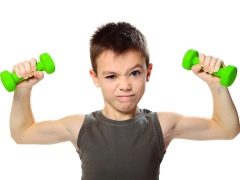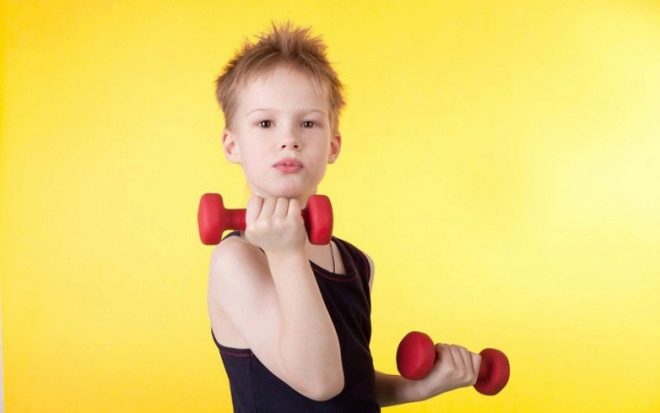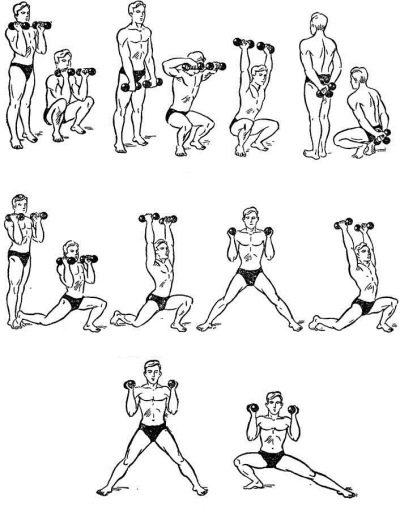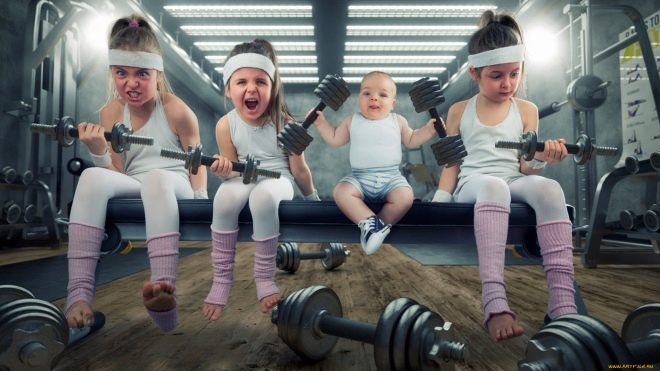Effective exercises with dumbbells for children
Every parent wants to see his child not only healthy, but also beautiful, because so much time is spent searching for a good interest group.
Classes can be held at home, but for this you need to know the basic laws of this process, to understand what can be given and at what age, to be able to plan the load for children of different ages. Strength training, especially with the use of dumbbells, require more careful study for effective use.
Special features
Charging and physical education with a child should start as soon as possible. If the baby is already confident in his arms and legs, as well as being able to repeat what he is shown, then this is the optimal time to start such activities. The complex should be made very carefully, taking into account the characteristics of the child. The older he gets, the more difficult the exercises will be.
Power loads at a younger age are unacceptable, and familiarity with dumbbells and training with them should be no earlier than 7 years old. It is at this age that the child already understands what is wanted from him, has a good control of his body and can work purposefully. Charging using this equipment should be infrequent, so that the baby does not get tired. Initially, power loads should be included only once a week, and gradually increase the number of such workouts.
Exercises with dumbbells for children should be lightened, and projectiles are best given specialized. An untrained child can hardly cope even with kilogram weighting, so initially the container must be empty.
When a small athlete learns to handle new sports accessories, they need to add content, most often it is sand. When the mass reaches the mark in kilogram, you can hand the child a real dumbbell.
The choice of equipment is very important in working with children, because it is worth buying only specialized dumbbells designed for children, they have a small weight, a thin arm so that the young athlete can grasp her tightly and fully carry out the exercise. It is also important what material the projectile is made of, best of all, so that it doesn’t slide in your hand and hold well; it is safe for the child and for his environment.
Before carrying out strength training with younger children, they need to prepare and increase the weight of weighting gradually. At the age of 10, schoolchildren are ready for much more serious workloads, so you can try a weight of two kilograms, but introduce it gradually.
The work of a teacher, trainer or parent who exercises or exercises with dumbbells should be in the proper selection of exercises, their dosage and control over the quality of each element.
The main complex
To conduct a full-fledged strength training, you need to start with a warm-up, where dumbbell exercises will already occur.
- Hand movements back and forth. You can conduct simultaneously or alternately.
- Squats, complicated by the presence of dumbbells in the hands that you need to keep in front of you.
- The turning movements of the body, complicated by dumbbells, which add amplitude.
In order for all movements to be performed correctly, a parent or trainer who knows exactly what to do must demonstrate them. It is important not to overdo it with the power unit both in the warm-up and in the main part of the lesson. Important components of the warm-up should be:
- exercises aimed at normalizing breathing, especially after heavy complexes;
- movements aimed at developing the muscles of the whole body.
All exercises that are selected for children of a certain age should be feasible for them, but not too easy. The pace of work should change in the course of the lesson, at first slow, then faster and finally slow down and hitch again.
Basic exercises with dumbbells that can be given to a child include several options.
- Bending of the arms in the elbow joints with dumbbells, where the biceps.
- Raise smooth hands on the sides. You can simultaneously or alternately for each hand.
- Raise even hands from bottom to top, above your head and return to the starting position.
- Squatting with dumbbells in hand.
- Breeding hands to the side in the supine position on a bench or step platform.
- Lean even hands back behind the body.
In addition to the power load, it is important to give a training complex with dumbbells, which will complicate the implementation of long-known movements and enhance their effect. These include several exercises.
- Tilt forward and down with dumbbells in hand. It is important to keep your back level, not to lower your head.
- Turns the body to the left and right, when the arms are bent at the elbows and holding dumbbells in front of the chest. The same exercise can be carried out with arms stretched forward, in which there is a weighting.
- Press, which is complicated by the presence of one or two dumbbells in his hands. You can clamp this equipment with your feet, while bending your knees.
- Lunges feet forward and to the sides with weighting in his hands.
Depending on the age of the child and his physical development, more complex complexes can be given, which are already aimed at working out the muscles, and in the case of a large number of repetitions, then the appearance of relief.
- Lowering the dumbbell behind the head and leading it to a vertical position. Each hand works alternately. The minimum number of repetitions for an untrained child will be 4 times with a subsequent increase to eight repetitions. Strengthened action will be from two eights for each hand.
- Breeding dumbbells on the sides, the body forward arched. The higher the hands are raised, the stronger the effect. The minimum number of repetitions - 4 times, the optimal 8 times with a repetition over time.
- Rises of legs between which feet the dumbbell is clamped. The position of the body can be both on the back and on the side, where the body also works additionally.
- Lifting the knee-bent leg, where the dumbbell is clamped and its abduction back up, then return to its original position on the floor with the support on the hands. Works right and left leg alternately.
After any strength training, it is important to hold a hitch using stretching or elements of Pilates. The necessary component will be breathing exercises, which after such a workout will be speeded up, which is unnatural for the normal state of the child.
It is important not to abuse the amount of strength training, because for a child's body, they in large quantities can be harmful instead of the expected benefits.
It is necessary to dose the load, correctly select the exercises according to the level of the child and determine the number of repetitions acceptable for him, gradually raising the minimum bar and achieving positive results. In the process of working with children, it is best to use dumbbells or other weighting compounds 1-2 times a week and not more.
Some effective exercises with dumbbells for children can be seen in the following video.





















